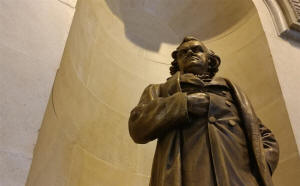Review of state monuments, statues begins at Statehouse
 Send a link to a friend
Send a link to a friend
[April 22, 2021]
By JERRY NOWICKI
Capitol News Illinois
jnowicki@capitolnewsillinois.com
 SPRINGFIELD – A House committee tasked with
reviewing statues and monuments on state property held its first meeting
Wednesday, hearing from professors and state government associations on
what frameworks can be established to guide the review process. SPRINGFIELD – A House committee tasked with
reviewing statues and monuments on state property held its first meeting
Wednesday, hearing from professors and state government associations on
what frameworks can be established to guide the review process.
Rep. Tim Butler, a Springfield Republican who serves as minority
spokesperson on the task force, said House Speaker Emanuel “Chris”
Welch’s creation of the review body is an “important and correct”
decision.
“The history of our state, much like history itself can be complicated,
nuanced and contradictory,” Butler said. “Who and what we honor through
memorialization often reflects those complications and nuances. And some
monuments which have been erected in previous generations certainly
conflict with the values we hold today.”
Butler said figures such as John W.E. Thomas, who was born a slave in
Alabama and in 1876 became the first African American elected to the
Illinois General Assembly, should have a place of honor in the Illinois
Capitol.

Butler also advocated for preserving the image of Abraham Lincoln and
Ulysses S. Grant, two former U.S. presidents with Illinois ties.
“While review and reevaluation are warranted on many things, advocating
removal of monuments for people like Lincoln and Grant really gives me
pause as to whether those who advocate for this position truly
understand the tremendous positive impacts individuals like them have
had on where our nation and world is today.”
Rep. Mary Flowers, who this year became the longest-serving Black
lawmaker in the state’s history, is the chair of the task force. The
Chicago Democrat said certain statues are indicative of “white
supremacy,” and the committee’s role will be “education, education,
education” on state monuments and their subjects.
“We cannot erase our history, our history is what it is,” she said. “But
the fact of the matter is the same way we have eliminated the colored
signs and the blacks only water fountains and bathrooms and different
things like that, with these statues, those are the reminders of the
past, as well as the white supremacy. And these are the things that we
need to eliminate because that's not who we are today.”
Flowers said there are statues “that have been erected to honor people
that have done some horrible things to other people.” While they might
not have a place at the Statehouse, she said, they could play a role in
history viewed in a broader context.
“I don't think that our committee is interested in destroying any
monuments, statues, I want them to be placed elsewhere to be talked
about so it would never happen again,” she said.
History and how it is written, told and portrayed in public spaces was a
major theme of the first task force hearing.
[to top of second column]
|

A statue of Stephen Douglas, who was a U.S.
Congressman, secretary of state and Supreme Court justice in
Illinois, is pictured at the Illinois State Capitol Wednesday. The
statue remains on the Statehouse's second floor, although a
different statue of Douglas was removed from the Capitol grounds
last year by former House Speaker Michael Madigan. A task force met
Wednesday to review all monuments on state property. (Capitol News
Illinois photo by Jerry Nowicki)

“What are the stories that demand a more complete and
honest retelling?” Linda Reneé Baker, a professor at Southern
Illinois University’s Paul Simon Public Policy Institute asked in
her committee testimony. “We can't erase the history, but we can
retell the stories, we can work with the historians to tell them in
a more factual manner, we can reframe the discussion in light of the
truth as we know it.”
Landscape architecture professor David Hays of the University of
Illinois spoke to the committee about how monuments can be used as
forms of oppression.
“And here, it's important to recall that history is not the same as
the past,” Hays said. “The past refers to events or conditions that
have already occurred and cannot be altered. In contrast, history is
the way the past is represented, interpreted and understood. So
history is always made in the present.”
History, Hays said “is always subjective. It's a matter of opinion,
even when anchored in facts.” The design of public places “plays a
significant role” in interpreting elements of the past and
translating them to the present.
An important question in analyzing art and public spaces is when and
why the artwork first came to be, he said. Many monuments to the
confederacy in the south and nationwide came to be in the 1920s,
“and they were definitely put up as part of a campaign of
intimidation,” he said.
“And that's the way in which it's really important to distinguish
between the past and interpretation of the past history,” he said.
Butler said Hays’ perspective will be a valuable one as the
committee educates itself on memorials to “complicated people.”
Flowers also noted that despite changing interpretations of the
past, “bigotry is bigotry,” and some monuments are romanticized
renderings of “how things used to be.”
“As a result of how things used to be, some people would like to
carry on that legacy at the risk or at the harm of other people,”
she said, noting some statues nationwide are “causing a lot of
problems and have caused a lot of problems” with the simplified
versions of the past they depict.
“History has been used, has been instrumentalized, to oppress people
for a very long time,” Hays responded. “History is written by the
victors, some say. But we can write history ourselves in ways that
are more consistent with our meanings and that's why I think it's
really important to say we can't change the past, but we can change
history.”
The committee will hold several hearings, Flowers said, although the
exact number is not decided yet, and then it will present
recommendations to the General Assembly.
On Wednesday, they also heard from the National Conference of State
Legislatures and the Council of State Governments to hear about
actions being taken in other states to address monuments on state
grounds.
Capitol News Illinois is a nonprofit, nonpartisan
news service covering state government and distributed to more than
400 newspapers statewide. It is funded primarily by the Illinois
Press Foundation and the Robert R. McCormick Foundation. |